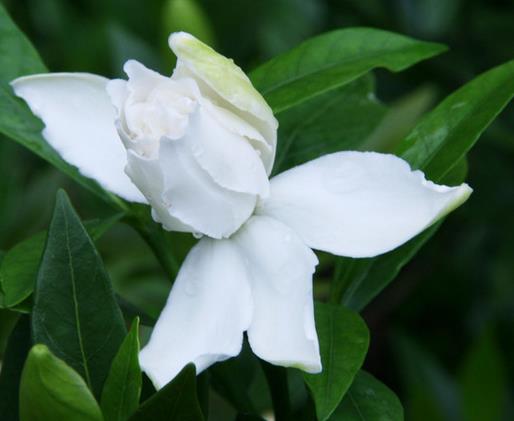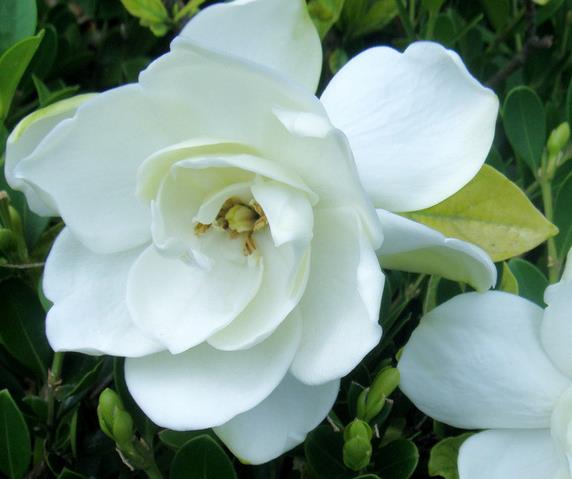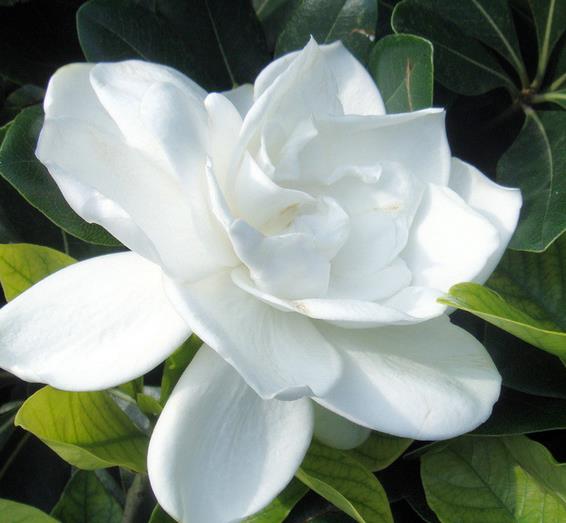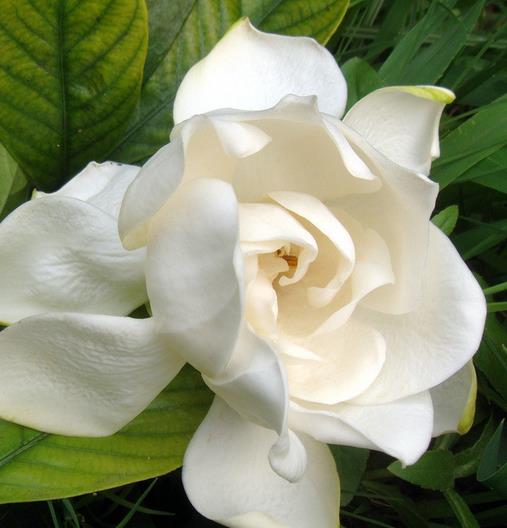The breeding methods of Gardenia jasminoides are introduced in detail. Matters needing attention in gardenia culture.
Gardenia can be propagated mainly by cutting and pressing method, and can also be propagated by sowing and split-plant method, or by water insertion and rooting method.

Introduction to the breeding methods of Gardenia jasminoides
1. Cuttage propagation
The north is in the greenhouse from October to November, and the south can be inserted from April to the Beginning of Autumn at any time, but the survival rate is the highest between summer and autumn. Cuttings choose healthy 2-year-old branches with a length of 10-12 cm, cut off the lower leaves, cut the lower end into a 45-degree angle, tie them into small bundles every 20 to 30, soak the slant in 0.05% rooting powder solution or 0.05% naphthalene acetic acid solution for 15 seconds, take out the drying solution and insert it into the sand. According to the row spacing 20~25cm, plant spacing 7~8cm, insert the cuttings bevel into the soil. Compacted and watered, set up a low shade shed for shade.
It can take root in about 15 days under the condition of 80% relative humidity and the temperature of 20-24 ℃. It is better to soak in indole butyric acid of-6 power of 20-10 to-6 power of 50-10 for 24 hours. When the rooting seedlings begin to grow, they can be transplanted or put on the pot for a single plant, and can blossom after 2 years. The north can also be propagated by water insertion, that is, the base of the cuttings is soaked in clean water, the water is changed once a day, and the water holder can grow new roots in a semi-shaded place for about 20 days. Weeding and topdressing should be strengthened (see seed breeding). After 1-2 years of cultivation, it can be transplanted when the seedling height is 40~50cm. This method can not only obtain a large number of seedlings, but also blossom and bear fruit earlier, and maintain the good characters of the female parent.
2. Striping propagation
In April, strong branches were selected from 3-year-old mother plants, which were 25 to 30 meters long for striping. If there were trigeminal branches, three seedlings could be obtained at the fork at one time. Generally, it can take root after 20-30 days, can be separated from the mother plant in June, and can be planted separately or single plant in the next spring.
3. Sowing and reproduction
Most of them are carried out in spring, and the seeds germinate slowly, germinate about 1 year after sowing and blossom after 3-4 years, but it is not easy to receive seeds in the northern pot.
1) seed selection: select plump, crimson ripe fruits, dried or dried in shells. Before sowing, cut the pericarp of the seeds with scissors, dig out the seeds, rub them in hot water, remove floating seeds or impurities, then fish out the sunken full seeds, spread them on the bamboo mat, put them in a ventilated place to dry too much moisture, and then sow the seeds.
2) Land selection and preparation: select the deep, loose and fertile sandy loam, plough 1-1.5 feet, start the border according to the width of 4-5 feet, the border height is 6 inches, apply 20-30 piculs of human feces per mu, wait for the soil to dry, shallow rake mud blocks, flatten the border surface. Sowing ditch is opened according to 6-7 inch row spacing on the border surface, and the ditch depth is about 1 inch to be sown.
3) sowing seedlings: spring sowing or autumn sowing, spring sowing before and after Rain Water, autumn sowing before and after the Autumn Equinox, sowing seeds mixed with fire ash evenly in the sowing ditch, and then covering the sowing ditch with fine soil or fiery soil, covering the grass with water, often keep the soil moist, in order to facilitate seedling emergence, 4-6 jin of seeds per mu.

Seedling management: after sowing, often watering to keep the border moist, about 20 days after emergence, remove the cover grass from the border, and then strengthen the management. When the seedlings grow 2-3 true leaves, the seedlings are thinned, the seedlings are too dense and weak, and when the seedlings grow 5 true leaves, the seedlings are kept according to the seedling distance 5~8cm, and frequently ploughed and weeded to maintain the growth of weeds in the seedling land. At the same time, proper topdressing should be carried out in the first year, once in spring, summer and autumn in the second year, and once in spring, summer, autumn and winter in spring, summer, autumn and winter. Combined with ploughing and weeding, 1000~1500kg was applied to human and animal manure every time per mu. From autumn sowing to the end of autumn and early winter in the second year, the seedlings can be planted when the seedling height is above 30cm, and the seedlings sown in spring can be planted when the seedlings reach 30cm in the next spring. If they do not reach the 30cm height, they will continue to be cultivated until the end of autumn and the beginning of winter. A large number of seedlings can be obtained by this method.
4) many tillering seedlings often grow around the rhizosphere of Gardenia jasminoides. Every year in early spring or late autumn and early winter, the strong-growing plants are selected, the topsoil around them are planed, and the tillering seedlings are cut off from the mother roots with a knife to be planted as seedlings.
4. Water inserting and rooting
The annual branches with a length of 10 to 12 meters and 2 leaves were taken. Cut the tip of the branch into a horseear and soak it in 0.1% potassium permanganate solution for 4 hours, then take it out and insert it into clean water. The length of the cuttings is the total length of the cuttings. The brown bottle is used as a container to change the water every 1 to 2 days. The cuttings can also be drilled in the wood or foam board to insert the cuttings into the holes and then float on the water.
After the new root is grown, it can be transplanted to pot or ground when it is moved from dark to bright, when the root length reaches 1.5-2 cm, and the number of roots per plant is 6-7.
Breeding methods and Culture skills of Gardenia jasminoides
First, sour soil culture, gardenia need scattered light, so like sour soil, if the soil is alkaline, it will make gardenia can not absorb iron very well, which has a great impact on the formation of chlorophyll, and further cause flower branches to wither and even die; so the soil must use loose, fertile acid soil, you can also add some substances with such effect.
The cultivation method of Gardenia jasminoides the leaves of Gardenia jasminoides are yellow and not blooming (Gardenia jasminoides has a good decorative effect)
Second, put in a cool place, gardenia must not be exposed to the scorching sun, otherwise the leaves will be withered and yellow, but it does not mean that it should be put in the whole shade, because it has a certain demand for light, it is best to keep 60% of the light every day, in addition, after entering April, fertilizing should be carried out twice a month.

Third, the air humidity, gardenia like to be wet, so the air can not be too dry, according to expert statistics, if the air humidity is less than 70%, it will affect the normal opening of flowers, but if it is too wet, it will cause rotting roots and yellow leaves, so in addition to normal watering, we should often spray clean water nearby. Another problem we should pay great attention to is that water should not be watered too much, otherwise it will also affect growth. So how to water gardenia?
A, when you see the soil is dry, knock on the flowerpot with your hand. If there is an empty sound, it needs watering. The bottom of the flowerpot starts to leak and stops. It is better to add some eggs and soy milk to the watering water, which is more conducive to growth.
The cultivation method of Gardenia jasminoides the leaves of Gardenia jasminoides are yellowing and not blooming (gardenia in full bloom, different beauty)
Fourth, fertilization tips, gardenia like fertilizer, but can not add too much fertilizer at one time, must be thin fertilizer, must not save trouble, otherwise it will cause thick branches, big leaves, thick green, it will lose its own appreciation effect.
Fifth, temperature requirements, the growth temperature of gardenia can not be too low, because it likes temperature, generally speaking, the temperature of the growing period is 18 to 22 degrees, 5 to 10 degrees in winter, and frostbite if it is less than 10 degrees below zero, which should be paid special attention to in the north.
Sixth, proper pruning, gardenia is very easy to grow luxuriant branches, and cause airtight and disorganized feeling, which will cause nutrition dispersion and poor ornamental, so it is necessary to prune it, it is best to choose three main branches when pruning, and cut off the roots and tillers to sprout new branches at any time, and the branches should be truncated in time after the flowers are shedding, so that new branches will sprout under the cut. When the new branch grows three nodes, it is necessary to pick the heart so as not to grow blindly.

The efficacy of breeding methods of Gardenia jasminoides
First, beautiful as flowers, people can not put it down.
Gardenia has luxuriant branches and leaves, evergreen leaves, fragrant and elegant flowers, green leaves and white flowers, especially beautiful and lovely, which is an excellent beautification material in the courtyard. It is suitable for front steps, poolside and roadside configurations, and can also be used for hedgerows, potted plants and bonsai, and flowers can also be used for flower arrangement and wear decoration.
Second, its drug value, you can not be underestimated.
Gardenia root, leaf, fruit can be used as medicine, have the effect of purging fire and removing annoyance, anti-inflammation and heat, clearing heat and diuresis, cooling blood and detoxification. In addition, Gardenia jasminoides is resistant to sulfur dioxide and can absorb sulfur to purify the atmosphere. 0.5 kg leaves can absorb 0.002-0.005 kg of sulfur. In addition to ornamental, gardenia, fruit, leaves and roots can be used as medicine, generally make tea or fried soup to take. Gardenia contains geniposide, dehydroxygeniposide, chicken rattan glycoside methyl ester and a small amount of geniposide, which has the effects of clearing away heat and diuresis, cooling blood and detoxification, jaundice, bloody pain, eye swelling, fire sore, lowering blood pressure and so on. Among them, gardenia fruit is used as medicine to treat fever and high fever, restlessness, toothache, sores in mouth and tongue, nasal rules, hematemesis, conjunctivitis, sore swelling, jaundice infectious hepatitis, broad bean disease, urine blood; external use to treat traumatic bleeding, contusion and contusion.
Third, usually we eat gardenia, but also have the effect of prevention and treatment.
1, clear heat and cool blood, gardenia bitter cold, can be divided into human blood and clear evil heat, is a sore swelling toxin, intestinal dysentery, blood-heat and other diseases of auxiliary treatment food.

2. Resolving phlegm and relieving cough, the effective ingredients of Gardenia jasminoides can inhibit the growth of bacteria, release sputum and unobstruct the airway, has the effect of resolving phlegm and relieving cough, and can be used as a food therapy for patients with cough caused by hot phlegm.
3, wide bowel laxation, anti-cancer gardenia contains cellulose, can promote colorectal peristalsis, help fecal excretion, prevent the occurrence of hemorrhoids and rectal cancer.
Third, the air humidity, gardenia like to be wet, so the air can not be too dry, according to expert statistics, if the air humidity is less than 70%, it will affect the normal opening of flowers, but if it is too wet, it will cause rotting roots and yellow leaves, so in addition to normal watering, we should often spray clean water nearby. Another problem we should pay great attention to is that water should not be watered too much, otherwise it will also affect growth. So how to water gardenia?
A, when you see the soil is dry, knock on the flowerpot with your hand. If there is an empty sound, it needs watering. The bottom of the flowerpot starts to leak and stops. It is better to add some eggs and soy milk to the watering water, which is more conducive to growth.
The cultivation method of Gardenia jasminoides the leaves of Gardenia jasminoides are yellowing and not blooming (gardenia in full bloom, different beauty)
Fourth, fertilization tips, gardenia like fertilizer, but can not add too much fertilizer at one time, must be thin fertilizer, must not save trouble, otherwise it will cause thick branches, big leaves, thick green, it will lose its own appreciation effect.
Fifth, temperature requirements, the growth temperature of gardenia can not be too low, because it likes temperature, generally speaking, the temperature of the growing period is 18 to 22 degrees, 5 to 10 degrees in winter, and frostbite if it is less than 10 degrees below zero, which should be paid special attention to in the north.
Sixth, proper pruning, gardenia is very easy to grow luxuriant branches, and cause airtight and disorganized feeling, which will cause nutrition dispersion and poor ornamental, so it is necessary to prune it, it is best to choose three main branches when pruning, and cut off the roots and tillers to sprout new branches at any time, and the branches should be truncated in time after the flowers are shedding, so that new branches will sprout under the cut. When the new branch grows three nodes, it is necessary to pick the heart so as not to grow blindly.

The efficacy of breeding methods of Gardenia jasminoides
First, beautiful as flowers, people can not put it down.
Gardenia has luxuriant branches and leaves, evergreen leaves, fragrant and elegant flowers, green leaves and white flowers, especially beautiful and lovely, which is an excellent beautification material in the courtyard. It is suitable for front steps, poolside and roadside configurations, and can also be used for hedgerows, potted plants and bonsai, and flowers can also be used for flower arrangement and wear decoration.
Second, its drug value, you can not be underestimated.
Gardenia root, leaf, fruit can be used as medicine, have the effect of purging fire and removing annoyance, anti-inflammation and heat, clearing heat and diuresis, cooling blood and detoxification. In addition, Gardenia jasminoides is resistant to sulfur dioxide and can absorb sulfur to purify the atmosphere. 0.5 kg leaves can absorb 0.002-0.005 kg of sulfur. In addition to ornamental, gardenia, fruit, leaves and roots can be used as medicine, generally make tea or fried soup to take. Gardenia contains geniposide, dehydroxygeniposide, chicken rattan glycoside methyl ester and a small amount of geniposide, which has the effects of clearing away heat and diuresis, cooling blood and detoxification, jaundice, bloody pain, eye swelling, fire sore, lowering blood pressure and so on. Among them, gardenia fruit is used as medicine to treat fever and high fever, restlessness, toothache, sores in mouth and tongue, nasal rules, hematemesis, conjunctivitis, sore swelling, jaundice infectious hepatitis, broad bean disease, urine blood; external use to treat traumatic bleeding, contusion and contusion.
Third, usually we eat gardenia, but also have the effect of prevention and treatment.
1, clear heat and cool blood, gardenia bitter cold, can be divided into human blood and clear evil heat, is a sore swelling toxin, intestinal dysentery, blood-heat and other diseases of auxiliary treatment food.

2. Resolving phlegm and relieving cough, the effective ingredients of Gardenia jasminoides can inhibit the growth of bacteria, release sputum and unobstruct the airway, has the effect of resolving phlegm and relieving cough, and can be used as a food therapy for patients with cough caused by hot phlegm.
3, wide bowel laxation, anti-cancer gardenia contains cellulose, can promote colorectal peristalsis, help fecal excretion, prevent the occurrence of hemorrhoids and rectal cancer.
Related
- Wuhan Hospital Iron Tree Blooming Result Was Instantly Frightened by the Gardener Master
- Which variety of camellia is the most fragrant and best? Which one do you like best?
- What is the small blue coat, the breeding methods and matters needing attention of the succulent plant
- Dormancy time and maintenance management of succulent plants during dormancy
- Minas succulent how to raise, Minas succulent plant pictures
- What are the varieties of winter succulent plants
- How to raise succulent plants in twelve rolls? let's take a look at some experience of breeding twelve rolls.
- Attention should be paid to water control for succulent plants during dormant period (winter and summer)
- Watering experience of twelve rolls of succulent plants
- Techniques for fertilizing succulent plants. An article will let you know how to fertilize succulent plants.



